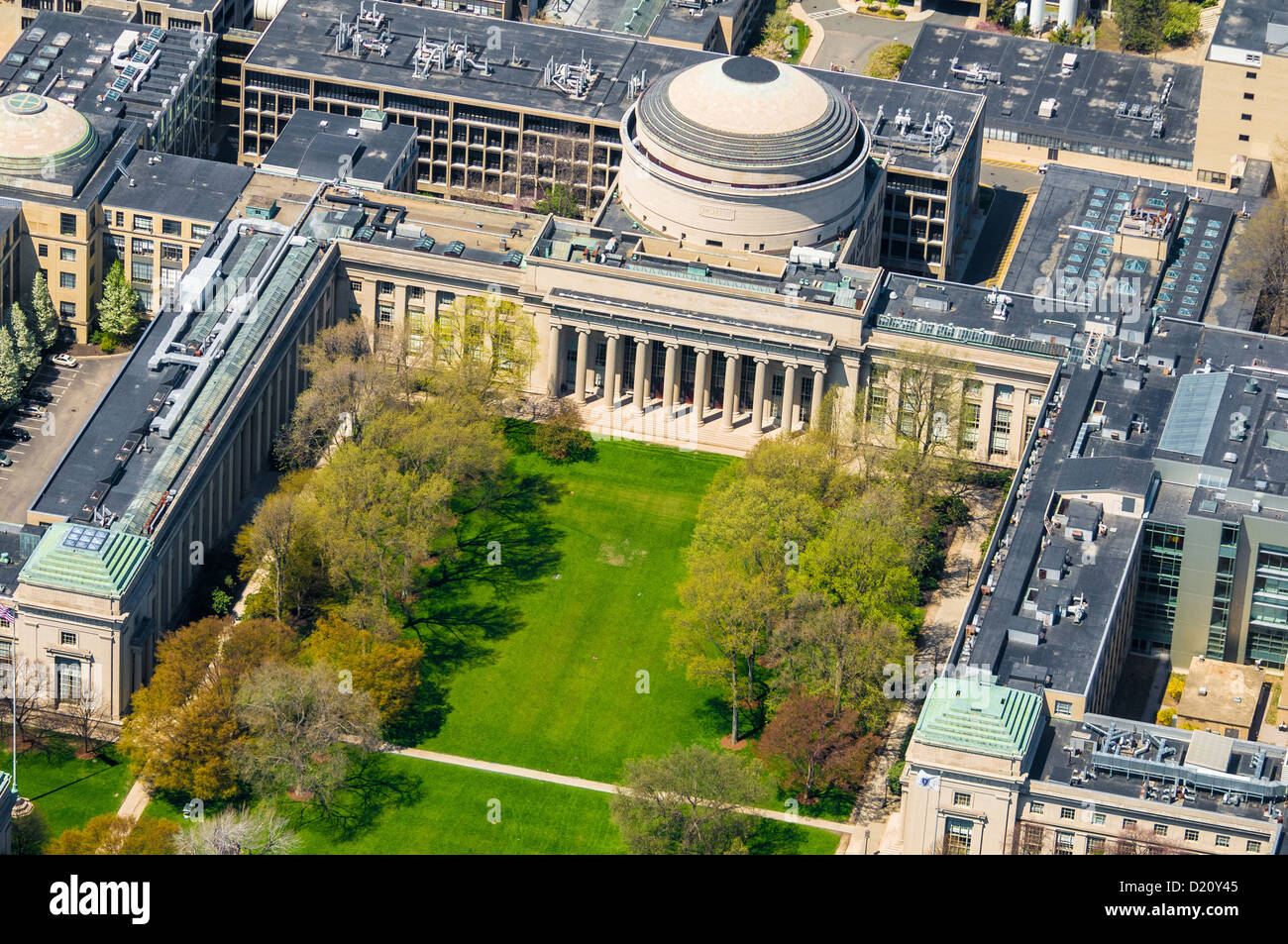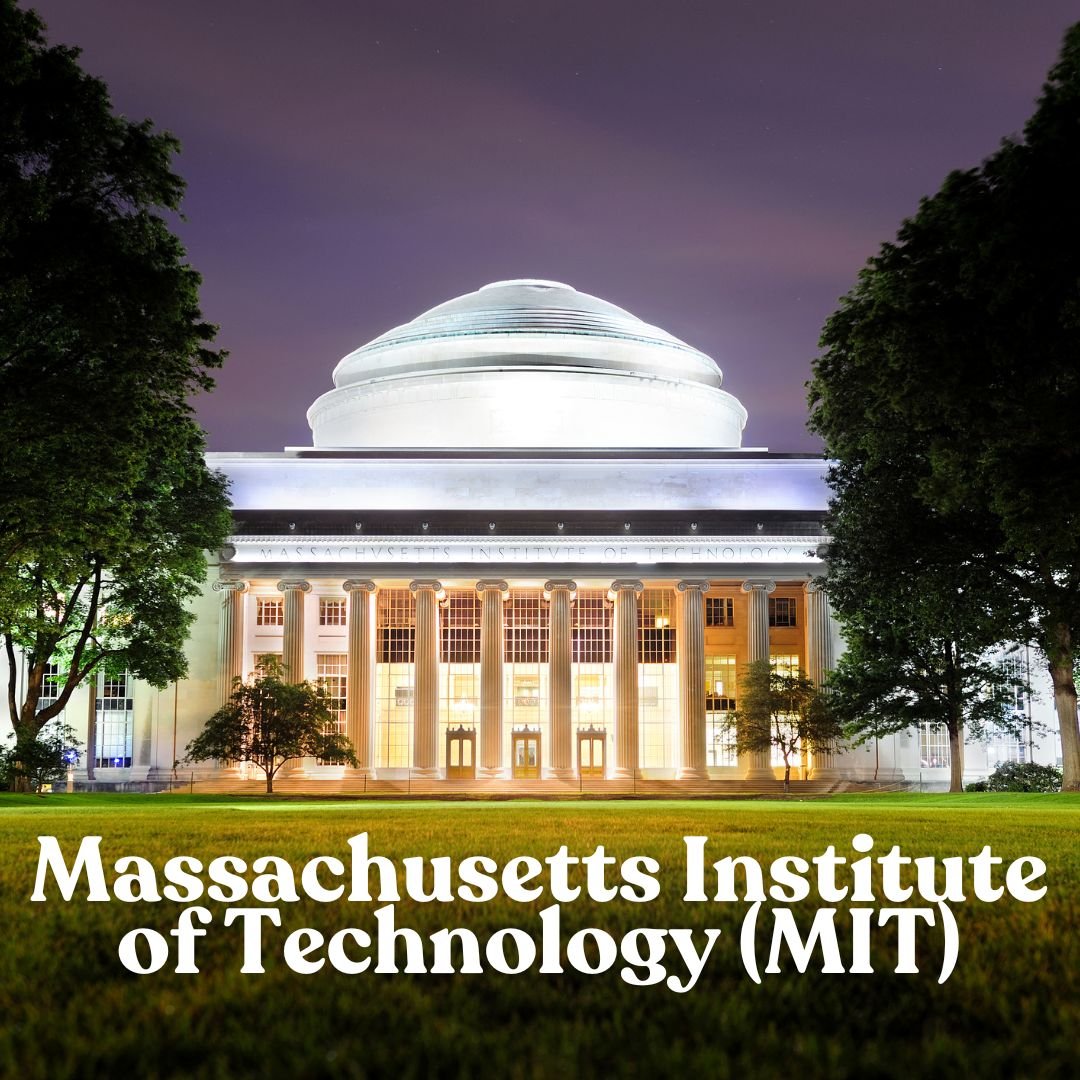Massachusetts Institute of Technology

Ah, the Massachusetts Institute of Technology—MIT, the hallowed halls where minds are molded, and the future is coded. Let’s take a stroll through its storied corridors, shall we?
🧠 The Genesis: From Vision to Reality
His brainchild, MIT, was founded with the motto Mens et Manus—”Mind and Hand”—emphasizing the fusion of intellectual rigor with practical application.
🏛️ The Evolution: From Boston to Cambridge
Beginning in Boston in 1865, MIT moved to its present 168-acre site in Cambridge, Massachusetts, which stretches along the Charles River, by 1916.This move marked the beginning of its transformation into a global research powerhouse.
🏫 The Structure: Schools and Programs
IT is divided into one college and five schools:
-
School of Architecture and Planning
-
School of Engineering
-
School of Humanities, Arts, and Social Sciences
-
School of Science
-
Sloan School of Management
-
MIT Schwarzman College of Computing
Each unit contributes to MIT’s interdisciplinary approach, fostering innovation across various fields.
🏆 The Impact: Contributions to Science and Technology
MIT’s influence is profound:
-
Nobel Laureates: Over 100
-
Turing Award Winners: 26
-
MacArthur Fellows: 84
-
National Medal of Science Recipients: 64
-
National Medal of Technology and Innovation Winners: 35
Its alumni and faculty have been instrumental in groundbreaking advancements, from the development of radar during World War II to pioneering work in artificial intelligence and quantum computing.
Academic Prowess: The Intellectual Powerhouse
MIT is more than just a university. It’s a breeding ground for some of the brightest minds on the planet. Every year, the competition to get in is fierce, with only around 7% of applicants accepted (mitadmissions.org). The academic programs are designed to challenge students in every sense: intellectually, emotionally, and creatively.
🏫 Hands-On Learning: MIT’s Approach to Education
While many institutions focus on lectures and theoretical concepts, MIT emphasizes learning by doing.
⚙️ The Tech Titan: MIT’s Innovations
MIT’s history is rich with groundbreaking discoveries. From the early days of radar technology to the invention of the first computer, the institution has always been at the cutting edge of technology. Some of the most iconic moments in tech history can be traced back to MIT:
-
The Creation of the Computer: MIT played a pivotal role in the birth of modern computing. The Whirlwind computer, developed at MIT, was one of the first systems capable of real-time computing.
-
MIT’s Artificial Intelligence Leadership: From machine learning to robotics, MIT has long been a leader in AI research. The university’s AI Lab (now part of CSAIL) has been at the heart of cutting-edge research for decades, contributing to everything from voice recognition to autonomous vehicles.
-
The Development of the Mouse: Yes, the computer mouse, that little device we all use, was invented at MIT by Douglas Engelbart and his team.
-
🌍 Global Influence: MIT Beyond the Campus
MIT isn’t just shaping the future in the lab or classroom. Its influence stretches across the globe through various collaborations and startups. In fact, it has been a launchpad for some of the world’s most successful startups.
-
Noam Chomsky – Often regarded as the father of modern linguistics, Chomsky’s influence extends beyond academia, shaping our understanding of human language and cognitive science.
-
🌎 The MIT Spirit: Collaboration, Community, and Diversity
MIT is a place that thrives on collaboration.Students from all walks of life come together to tackle complex problems, with a shared belief that collective intelligence leads to the best solutions.
The university also embraces diversity. MIT’s Office of Minority Education works to ensure underrepresented groups in STEM have the support they need to thrive, while MIT’s International Scholars Program brings in talent from all around the world.
About Massachusetts Institute of Technology
The Massachusetts Institute of Technology’s (MIT) provocative motto is “Mind and Hand.” This catchy tagline encapsulates the esteemed university’s mission to advance scholarship, science, and technology in order to improve society.
With more than 11,000 undergraduate and graduate students and over 1,000 faculty members, MIT has expanded into a huge educational institution.
🏅 Prestige and Recognition
MIT’s prestige doesn’t stop at its physical campus.
🗣️ A Call to Innovate
MIT is a shining example of creativity, tenacity, and discovery, regardless of whether you’re a prospective student, a tech enthusiast, or just an inquisitive mind. It’s about influencing the future, not simply about what’s being done now.
🔬 MIT Research: Frontier of Knowledge
At MIT, research is the foundation of the university, not merely a side endeavor. One of the best research universities in the world, MIT regularly spends more than $3 billion on research each year. Here are a some of the incredible projects that are currently underway:
-
MIT’s Search for Artificial Intelligence: MIT’s AI research aims to enhance human lives, not only build more intelligent robots. MIT’s Computer Science and Artificial Intelligence Laboratory, or CSAIL, is pushing the envelope in fields including deep learning, self-driving cars, and human-computer collabora
🏅 MIT Alumni: The Movers and Shakers
MIT’s alumni network is like a Who’s Who of innovators, entrepreneurs, and thinkers who have reshaped industries, changed lives, and impacted global events. Just a few names:
-
Kofi Annan – The late Kofi Annan, former Secretary-General of the United Nations and Nobel Peace Prize laureate, graduated from MIT with a degree in management. His impact on world diplomacy is felt to this day.
-
Elon Musk – Though Musk didn’t finish his degree at MIT (he dropped out to pursue ventures in tech), he is undoubtedly one of the university’s most famous—and controversial—alumni. Through companies like Tesla, SpaceX, and Neuralink, Musk has become a leading figure in sustainable technology and space exploration.
-
Richard Feynman – The legendary physicist and Nobel laureate, known for his contributions to quantum mechanics and quantum electrodynamics, was a professor at MIT and later at Caltech. Feynman’s legacy lives on in the Feynman diagrams, used to describe the behavior of subatomic particles.
-
Rajiv Suri – The CEO of Nokia and CEO of Inmarsat, Rajiv Suri completed his undergraduate studies at MIT, contributing to the development of mobile telecommunications.
-
His work at MIT, combined with his entrepreneurial spirit, led to the creation of one of the foundational technologies of the modern internet.
-
📚 The MIT OpenCourseWare (OCW) Revolution
One of the most revolutionary aspects of MIT is its OpenCourseWare (OCW) initiative. Launched in 2001, this program provides free online access to almost all of MIT’s course materials. From lecture notes to assignments and exams, MIT’s OpenCourseWare makes high-quality educational resources accessible to anyone with an internet connection, empowering learners across the globe.
Some stats to blow your mind:
-
Over 2000 courses are available online, covering subjects from engineering and computer science to art and humanities.
-
That’s an education revolution in action!
-

-
🏫 Campus Life at MIT: The Thriving Community
While MIT is undoubtedly a serious academic institution, the campus life reflects its commitment to fostering a well-rounded and balanced experience for students.
-
Residential Life: MIT has an extensive system of student residences designed to encourage both community and independence. Whether you live in one of the dorms, houses, or fraternities/sororities, MIT’s residential system ensures that students have a support network and space to thrive.
-
Diversity & Inclusion: The MIT campus has always prioritized diversity and inclusion. The MIT Diversity, Equity, and Inclusion Office works tirelessly to foster a welcoming environment for everyone, from students of color to those of different sexual orientations, gender identities, and backgrounds.
-
Extracurriculars: If you thought MIT students only spent their time studying, think again. There’s a massive variety of clubs and organizations, from robotics teams to student-run startups to hackathons.
-
Innovation Week: One of the coolest events at MIT is the MIT Innovation Week—a week-long celebration of entrepreneurship and creativity. Students, faculty, and alumni come together to pitch ideas, solve real-world problems, and celebrate the spirit of innovation.
-
Athletics and Recreation: MIT may be known for its brains, but it’s got plenty of brawn too. Whether you want to engage in a competitive sport, get involved in fitness activities, or just chill out with some yoga, MIT’s sports facilities are state-of-the-art. Plus, it has an impressive array of intramural sports, including ultimate frisbee, soccer, and fencing.
🌱 Sustainability at MIT: A Greener Future
MIT is committed to being a leader in sustainability. The MIT Office of Sustainability runs initiatives such as:
-
Sustainable Campus Design: MIT’s campus buildings are designed with sustainability in mind. For example, the Zesiger Sports and Fitness Center is one of the most energy-efficient buildings on campus, using renewable energy and innovative green technology.
-
Zero Waste Goals: MIT is pushing toward zero waste by implementing programs to reduce, reuse, and recycle materials across campus. The university’s green buildings are certified under LEED (Leadership in Energy and Environmental Design), setting a high bar for campus sustainability.
-
The MIT Environmental Solutions Initiative works with organizations globally to develop sustainable technologies that tackle pressing challenges like water scarcity, clean energy, and climate change.
🚀 Looking to the Future: The Horizon of Innovation
As the future unfolds, MIT’s bold vision continues to expand. From deep space exploration to personalized medicine, MIT is shaping tomorrow, today. The institution’s future labs and research centers are constantly evolving to stay ahead of the curve.
In a nutshell, MIT isn’t just an academic institution—it’s a living, breathing ecosystem of ideas, creativity, and possibility. It’s a space where the brightest minds in the world come together to tackle some of the most complex challenges of our time. And with its mix of fierce academic rigor, groundbreaking research, and relentless innovation, MIT remains a powerhouse shaping the future in ways we can only begin to imagine.
So, what do you think? Maybe it’s time to grab that MIT hoodie. 😉
-
Massachusetts Institute of Technology
MIT’s five schools—architecture and planning, engineering, humanities, arts and social sciences, management, and science—and the single college of computers comprise this autonomous, coeducational, privately funded university. However, the foundation of MIT’s educational philosophy continues to be educational innovation.
While MIT research has historically fueled scientific breakthroughs like the development of radar, the invention of magnetic core memory, and the concept of the expanding universe, its researchers are currently at the forefront of advancements in artificial intelligence, climate adaptation, HIV, cancer, and poverty alleviation.
However, MIT has more to offer than just science and technology. With 33 varsity sports, MIT has one of the world’s most extensive intercollegiate athletic programs, with over 20% of its undergraduate students participating in athletics.
College life is infused with a thriving artistic culture as well. The campus is home to 12 museums and galleries, with the MIT Museum receiving close to 125,000 visitors annually.
At its periphery, the campus blends with several Cambridge communities, such as Kendall Square, one of the world’s most inventive square miles. Because of the tight relationship between industry and research, MIT alums have launched over 30,000 active companies, producing 4.6 million employees and earning over $1.9 trillion in revenue annually. Therefore, it is not surprising that a country with MIT graduates would be equal to the tenth-largest economy in the world.
The process of choosing the best scholarship can be intimidating. With so many options at their disposal, students frequently feel overloaded and perplexed. The choice might be particularly difficult for people with limited resources or those pursuing particular academic or professional objectives.
We suggest the following articles to assist students in navigating this complex process:
Admission to MIT University for MS in 2025
View the Study Guide for International Students in the United States.
| Particulars | Stats 2025 |
|---|---|
| Application portal | UG: apply.mitadmissions.org/portal/apply PG: apply.mit.edu/apply or vary by program MBA: applymitsloan.mit.edu/register/apply |
| Application fee | UG: USD 75 or INR 6278.31 PG: USD 75 or INR 6278.31 MBA: USD 250 or INR 20,927.69 |
| ELP tests accepted | TOEFL IELTS PTE Duolingo (DET) |
| Standardized test scores | PG: GRE / GMAT (as per course requirement) UG: SAT / ACT |
| MIT admissions deadlines | UG: Nov 01, 2025 (early action) PG: Varies as per courses |

Key Points for MIT University Admissions in 2025
Massachusetts Institute of Technology
Beginning in their final year of high school, international students can start the application process for MIT. They can apply by simply following the MIT University admissions procedures. Students must fulfill the prerequisites for the course they wish to take. Students who do not speak English as their first language must pass the MIT University IELTS or another English language exam to get admitted. To submit their admission applications, applicants must additionally pay a non-refundable application fee. The following are the key details about university admissions for students:
Courses & Fees at MIT University in 2025
| PG Programs | Academic Qualifications | English Proficiency Requirements | Documents Required | Interview |
|---|---|---|---|---|
| MS | Complete a bachelor’s degree Official GRE test scores Official TOEFL or IELTS English proficiency exam test scores Submit Letters of Recommendations | TOEFL: 90 – 100, IELTS: 7 – 7.5, GRE | Academic transcripts LORs SOP GRE test scores TOEFL or IELTS scores Transcripts CV or resume | Required |
| MBA/PGDM | Complete a bachelor’s degree Official GRE test scores Official TOEFL or IELTS English proficiency exam test scores Submit Letters of Recommendations | 90 – 100, GRE: 320 & Above, GMAT: 700 & Above | Academic transcripts LORs SOP GRE test scores TOEFL or IELTS scores Transcripts CV or resume | Required |
| MIM | Complete a bachelor’s degree Official GRE test scores Official TOEFL or IELTS English proficiency exam test scores Submit Letters of Recommendations | TOEFL: 90 – 100, GRE: 320 & Above, IELTS: 7 – 7.5, GMAT: 700 & Above | Academic transcripts LORs SOP GRE test scores TOEFL or IELTS scores Transcripts CV or resume | Not required |
| MEng | Complete a bachelor’s degree Official GRE test scores Official TOEFL or IELTS English proficiency exam test scores Submit Letters of Recommendations | IELTS: 7.5 & Above, TOEFL: 100 & Above | Academic transcripts LORs SOP GRE test scores TOEFL or IELTS scores Transcripts CV or resume | Not required |
| Executive MBA/PGDM | Complete a bachelor’s degree Official GRE test scores Official TOEFL or IELTS English proficiency exam test scores Submit Letters of Recommendations | TOEFL | Academic transcripts LORs SOP GRE test scores TOEFL or IELTS scores Transcripts CV or resume | Required |
Over 110 undergraduate and graduate courses are available to international students at MIT University. Aerospace engineering, architecture, chemistry, and finance are a few of the most popular courses.Massachusetts Institute of Technology.
Mechanical Engineering, Architecture, and MBA programs are common choices for master’s degrees. Depending on the curriculum, the Massachusetts Institute of Technology charges Indian students fees ranging from INR 35 lakh to INR 1 crore. Massachusetts Institute of Technology
Applicants must fulfill the particular requirements for their program of choice to be admitted. The university’s graduate programs and prerequisites are shown below:
The table below shows the undergraduate programs along with the eligibility requirements for MIT:
| UG Programs | Academic Qualifications | English Proficiency Requirements | Documents Required | Interview |
|---|---|---|---|---|
| BE/BTech | Complete a high school degree First-year applicants require the SAT or the ACT | TOEFL: 90 & Above, IELTS: 7 – 7.5, PTE: 65 & Above | Transcripts Letters of recommendation Tests & scores Creative portfolios | Required |
| BBA | Complete a high school degree First-year applicants require the SAT or the ACT | TOEFL: 90 & Above, IELTS: 7 & Above, PTE: 65 & Above, Duolingo: 120 & Above, SAT | Transcripts Letters of recommendation Tests & scores Creative portfolios | Not required |
| BSc | Complete a high school degree First-year applicants require the SAT or the ACT | TOEFL: 90 & Above, IELTS: 7 & Above, PTE: 65 & Above, Duolingo: 120 & Above, SAT | Transcripts Letters of recommendation Tests & scores Creative portfolios | Not required |
| BArch | Complete a high school degree First-year applicants require the SAT or the ACT | TOEFL: 90 & Above, IELTS: 7 & Above, PTE: 65 & Above, Duolingo: 120 & Above | Transcripts Letters of recommendation Tests & scores Creative portfolios | Not required |
| BJMC | Complete a high school degree First-year applicants require the SAT or the ACT | TOEFL: 90 & Above | Transcripts Letters of recommendation Tests & scores Creative portfolios | Not required |
See also: International Students’ Cost of Living in the United States
Fees for International Students at Massachusetts Institute of Technology in 2025
One of the most well-known colleges in the world is MIT. It offers pupils a top-notch education at a fair cost. For the first year, MIT costs range from INR 35 L to INR 1 Cr. The Massachusetts Institute of Technology costs for overseas students are displayed in the table below: Massachusetts Institute of Technology
| Courses | 1st Year Tuition Fees |
|---|---|
| MBA/PGDM | INR 35 L – 76 L |
| B.E. / B.Tech | INR 50 L – 52 L |
| MS | INR 45 L – 70 L |
| MIM | INR 35 L – 76 L |
| BSc | INR 50 L – 52 L |
| MEng | INR 48 L – 52 L |
| BArch | INR 50 L – 52 L |
| PG Certificate | INR 50 L |
| BJMC | INR 52 L |
| Executive MBA/PGDM | INR 1 Cr |









